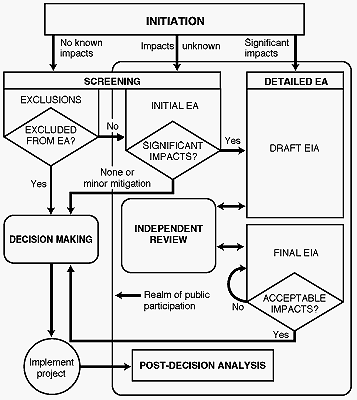


A flowchart of the environmental assessment process is shown
above.

What is environmental assessment?

Environmental impact assessment (EIA) is a process for evaluating the environmental and social consequences of proposed activities. The goals of EIA are the prediction of impacts, better decision making, and the minimization of adverse impacts to the environment.
Staff at the Oak Ridge National Laboratory prepared a source-book on the EIA process for the U.S. Environmental Protection Agency. The major activities that are required for successful EIA include: initiation, scoping, assessment, decision making, and post-decision analysis. Each of these activities is described in terms of needs, tools, issues, linkages, and references.
The source book is designed for reviewers and preparers of environmental documents and as a training guide for government agencies and nongovernmental organizations in both developed and developing countries.

L. L. Sigal. 1993. Sourcebook for the Environmental Assessment Process. EPA 300-B-93-007. U.S. Environmental Protection Agency. Washington, D.C.
Integrated Assessment Briefs. 1995. ORNL/M-4227. Oak Ridge National Laboratory, Oak Ridge, TN.